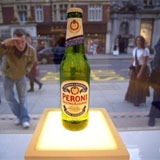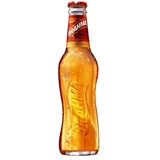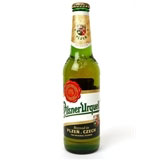Winning brew

The FIFA World Cup is about much more than just football – for brewers, it’s a top marketing opportunity. David Benady argues that there’s often a curious link between national characteristics and a country’s beers
Major brewing nations the Czech Republic, Germany, England, The Netherlands and Mexico will all be vying for glory during the FIFA World Cup football championships this summer. At the same time, brewers from these countries will be trying to ensure that their brands earn a place in the super league of top-selling beers.
In fact, some designers see a connection between behaviour on the football pitch and the way a nation’s beer brands are packaged. Consider, for instance, Brazilian lager Brahma, launched by Inbev in the UK last year. It has adopted a playful, swaying design created by branding consultancy FutureBrand, which seems to match perfectly the football team’s fancy-footed skills. According to the consultancy’s strategy chief Adrian Goldthorpe, the curved bottle design was created to represent the Brazilian concept of ‘Ginga’, which roughly translates as ‘effortless flair’.
‘The way David Beckham gets around a man is by crossing the ball or kicking it past the defender and running around him. But Ronaldo dances. He looks as if he goes through the guy. It’s all about the hips. It’s a fluidity that exists in Brazilian life. Ipanema Beach is curved, the women are curved, the way people play football is curved,’ says Goldthorpe. Already the world’s sixth biggest beer brand, Brahma’s UK roll-out has included an ad campaign, this year, using designs by Brazilian artist Speto.
FutureBrand has also created branding for the new Beck’s Vier, a weaker, 4 per cent variant. The product maintains the clinical, precise design attributes of the master brand, denoting the purity for which German beers are famed.

Andy Knowles, chief executive of Jones Knowles Ritchie, thinks the crisp, engineered packaging design of Beck’s perfectly matches Germany’s highly organised – though somewhat dull – style of football. ‘It is very polished and precise. It fits our stereotypes of German engineering,’ he says.
Meanwhile, Mexico’s Corona lager has enjoyed considerable success in the UK, with its old-fashioned bottle that looks as though a designer hasn’t been anywhere near it. It uses applied ceramic labelling, a screen printing technique, to graft its name on to the glass. Along with Dos Equis and Sol, Mexican beers are on the rise, though, like their football team, some believe their appeal lies in being rather rough and ready, a touch old-fashioned and even a little kitsch. It will become clear, soon enough, whether these brands have been able to create a new Mexican wave in beer.
The US fields a team that is not expected to perform strongly in the tournament, and sales of its lagers have been lacklustre in the UK, at least. Budweiser – the official beer of the World Cup – sums up the image of US incursions into the worlds of football and global beer with the strapline of its ad campaign, ‘You do the football, we’ll do the beer.’ US lager brands, such as Bud, have no pretensions towards authenticity or heritage, and come across as relatively brash and promotional against the heavily trailed provenance of European beers.
However, some believe it is a mistake to give the design of packaged lagers too much youth appeal. Enterprise IG chairman Dave Brown says, ‘Lots of new players are extending their ranges to make the age profile lower and brands more youthful. People use primary packaging to do that, but it’s a mistake. Make packaging design authentic and communicate through advertising.’
The authenticity and provenance of beers is a major selling point for many of them, and packaging design is crucial to preserving this identity, he believes. Enterprise has worked on a number of top global beers owned by giant SAB Miller. One of the biggest challengers ‹ for the beer world cup is Italian brand Peroni Nastro Azzurro (plain Peroni outside Italy), which uses the premium cues of Italy’s designer culture on its packaging. For its relaunch last year, Enterprise took it out of its dumpy bottle and put it in a sleeker, long-necked bottle. The brand language was revised to reinforce the Italian credentials, and the image of classy sophistication is carried through an ad campaign using images from Fellini’s classic film La Dolce Vita.
In the World Cup, Italy faces a qualifying game against the Czech Republic, while in the beer market the stylish Italian lager is up against some powerful Czech beer brands. SAB Miller’s Pilsner Urquell is a top Czech lager and its packaging is laden with national iconography, prominently featuring the crest, the red seal and its name written in Art Nouveau graphics. These support its claim to be ‘the original pilsner’. Other Czech lagers that emphasise this authenticity include Staropramen and Budweiser Budvar.

The Netherlands will surely be a winner on the pitch and in the beer market with Heineken and Grolsch. Japan will face Australia, pitting Kirin and Asahi against Foster’s and Castlemaine XXXX. But let us not forget Portugal’s Sagres, Ghana’s Star and Ivory Coast brand Flag.
Typically, English designers are unenthused by this country’s lager or its football prowess. Some believe top-selling lager Carling is representative of the way we play the national game, being dependable and hard-working, but without much excitement. But JKR’s Knowles puts forward his consultancy’s design work for Bass Ale, featuring a large, red trademark triangle, as a perfect metaphor for English football. ‘Red is for danger, and maybe that is the English thing. They are an unknown quantity this time – so close, yet so far. They are red-blooded and full on. They might just win.’ l
-
Post a comment




